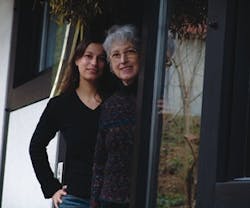Getting a Move on Aging in Place
For more than 40 years, my aunt and uncle lived in a lovely little house in La Jolla, CA. It was the quintessential Sunset home—a low-slung, mid-century modern dwelling that, when it was being built, had my uncle’s friends and family shaking their heads saying, “Hire an architect? That’s crazy!”
In its now classic style, the house represented who they were and how they lived—open, natural and modest, with clear connections to their surroundings. They and their iconic home were the focal point of our family. How troubling it was, then, to see it become difficult for them to inhabit as they moved into their eighth decade of life.
One-step level changes, throw rugs, stairs, walls of glass, standard height toilets and other features we take for granted in good health become a series of hazards and barriers when eyesight begins to fail, bones grow brittle, strength wanes and equilibrium wavers.
Increasingly discouraged, our family grappled with how to deal with the issue, wanting more than anything for my aunt and uncle, the last of their generation, to be able to stay in their beloved home. This was more than 10 years ago, and resources were scarce. I landed on the idea of tapping a friend who, as an occupational and physical therapist, conducted home evaluations in service of accommodating physical challenges.
My friend observed my aunt and uncle in their home for three days and then, with great compassion, suggested new routines, taught strategies for coping (e.g., ways to get up if they fall) and proposed changes to the home.
As we consulted medical supply catalogues for grab bars and other helpful features, it became clear to me just how limited the tool set was for making changes in ways that respected their home and lifestyle. Moreover, what an opportunity that lack presented for designers! Can’t we retrofit a house without making it feel like a hospital?
“Aging in Place” is a major opportunity for interior designers. It is also one of four ASID platform issues (and the final one I’ll discuss in this column, after covering legislation, education and sustainability).
We can make a difference in this arena. While many organizations are nibbling around the edges of aging-related design—from AARP and NAHB to AIA—none has taken on a defining role; no particular profession or organization “owns it,” and none has more to offer (or to gain) than ASID and its members.
Right now, our Design for Aging Council, chaired by Kerrie Kelly, is in the early stages of exploring how interior designers can meet the needs and wishes of an older population, as well as how the “age wave” will affect interior design across all areas of practice and specialty.
It’s already clear that design for aging offers a host of new business avenues, including certification opportunities, interesting partnership possibilities and different revenue sources related to new services and products. Above all, addressing older people’s in-home needs manifests the Society’s vision of interior design as a means for “enhancing the psychological, economic and physical quality of people’s lives”—a core value at ASID.
“This is as big as sustainability,” says Kelly. The vision? Lead a collaboration with other industry professionals—from builders and manufacturers to occupational therapists and elder advocates—toward the formation of a central authority on the topic of aging in place—or as Kelly’s clients like to say, “aging in motion.”
My uncle was able to stay in his home until he died. My aunt eventually needed to move to an assisted living facility. But the changes we made, working together as designer and medical professional, allowed them stay in their home for as long as they did—a priceless gift of comfort, dignity and sanctuary in their final years, and a gift for us, the generations they had nurtured for so many years.
ASID president Sari Graven is the director of planning and resource development at Seattle University’s Facilities Services. ASID can be reached at (202) 546-3480 or [email protected], and on the Web at www.asid.org.
